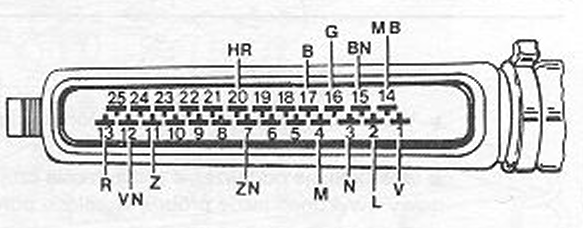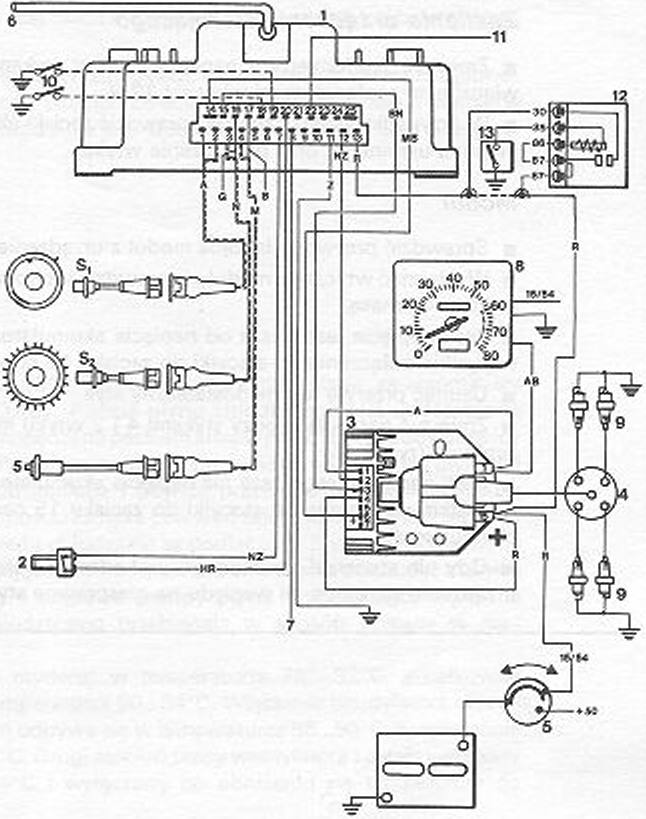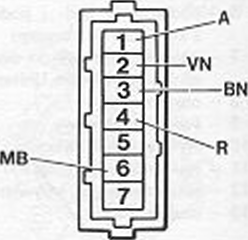Checking the ignition system
To test the operation of the electrical components of the ignition system, you must use a voltmeter and ohmmeter.
Connecting cables for the control device
■ Pull the plug out of the control device (Lynx. 3.44) and check the circuits continuity with an ohmmeter according to the diagram in the figure 3.43.
and check the circuits continuity with an ohmmeter according to the diagram in the figure 3.43.
■ Search for circuit breaks and remove them.
Rotation sensor at the handwheel
■ Measure the resistance between contacts 3 and 16 plug. At 20ºC, it must be 618…748 Oh.
■ If the resistance exceeds the specified range, measure directly at the sensor. Replace cable or sensor, depending on the result.
■ The air gap between the sensor and the ZZ mark must be 0.4…1,0 Mm. To check it out, use a feeler gauge to set the plunger 1. cylinder to position ZZ. The gap size can be adjusted, loosening the handle.
ZZ position sensor at the pulley
■ Measure the resistance between contacts 1 and 2 plug. At 20 ° C, it must be 618…748 Oh. Otherwise, measure directly at the sensor. Depending on the result of replacing the cable or the sensor.
■ Set the air gap as for the rotation sensor.
Power supply to the control device
■ Measure the voltage between the contacts with a voltmeter 13 and 11 plug with the ignition on: must be 12 V.
■ In case of lack of voltage, check the battery terminals, especially the negative pole, and plug connection.
Module
■ Check the wires connecting the module to the control device.
■ Pull the plug out of the module and check the voltage between the contact with a voltmeter 4 and mass.
■ If the voltage is lower than the battery voltage, all connections from the ignition switch to the terminal should be checked 15 ignition coil.
■ Remove gap or insufficient contact.
■ Measure the voltage between the contacts 4 and 2 the module plug with the ignition on (Lynx. 3.45).
■ If the voltage is lower than the battery voltage, all connections from the ignition switch to the terminal should be checked 15 ignition coil and battery ground.
■ When no connection damage is found, the control device must be replaced, due to faulty contacts 11 and 12.
Knock sensor
■ Sensor defect manifests a tendency to knock burning or a decrease in power.
■ If there is a suspicion of sensor damage, replace it with a new one and perform a test drive for comparison.
■ Engine ringing can be caused by over-machining of the head (too much compression), incorrectly selected spark plugs or incorrect position sensor ZZ setting on the pulley.
Ignition coil and distributor
■ Disconnect the wires from the terminals before inspection 1 and 15 ignition coil.
■ Measure the resistance of the primary winding, which must be 0,31 …0.37 Oh.
■ Measure the resistance of the secondary winding, which must be 3300…4070 Oh.
■ Check the high-voltage wires with an ohmmeter. In the event of a defect, replace the entire set of cables.
■ The resistance of the splitter finger must be within 800…1200 Q
■ If no defect is found in the teams in question, it is necessary to replace the module.
Often, in the event of a malfunction of the ignition system, the fault location cannot be found unequivocally. It is then recommended to replace the actuator first (module), and if the defect persists, control device.